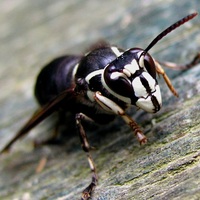The bald-faced hornet gets its name from its white or bald face. These pests have a very painful sting to which some people have severe allergic reactions.
 How to Identify Bald-Faced Hornets
How to Identify Bald-Faced Hornets
Yellow jackets, honey bees, wasps, and hornets instill fear in many people. The bald-faced hornet is one of the most fearsome, because of its painful sting. This is one of 16 different species of yellowjacket wasps in the United States. The bald-faced hornet is 1/2 to 3/4 inches long. Queens are nearly the same size as the workers. Workers, however, are covered with small hairs, while the queens are bare. the bald-faced hornet worker’s color is black with white markings. These pests are also known as bald hornets, white-faced or white-tailed hornets, spruce wasps, blackjackets, and bull wasps.
The Biology and Habits of Bald-Faced Hornets
The bald-faced hornet is a social insect that lives in nests and/or colonies. It builds a characteristic large, hanging paper nest which may be up to 20 inches in length. Nests are constructed in trees or shrubs. Occasionally, nests may be built on the sides of buildings. Nests will contain anywhere between 400 and 700 workers. Workers will aggressively defend their nest by repeatedly stinging threats. Only fertilized queens overwinter and they do so in a protected place. In the spring, the queen chews up cellulose material and makes a small nest about the size of a golf ball.
Where do You See Bald-Faced Hornets?
- On occasion, you may notice a stream of bald-faced hornets, and be able to follow them to their nesting site, especially nests built in shrubs.
- Make sure you maintain a safe distance from the nest to avoid being stung.
- Do not disturb the nest in any way.
- Many times, you get just a short glimpse of them out of the corner of your eye and if you do not recognize the danger of their presence, you are going to be stung. Bald-faced hornets aggresively protect their colony or nest.
Ways to reduce the appearance of bald-faced hornets in your home:
- Repair or install tight-fitting screens on windows, doors, gables, foundation and soffit vents.
- Install weather stripping and door sweeps.
- Seal gaps around doors and windows.
- Seal all siding with good exterior caulk.
- Repair any dryer and bathroom vents.
- Move hummingbird feeders away from your home.
- Repair foundation cracks.
- Seal around HVAC systems.
- Seek professional assistance and a pest elimination plan.
Ways to reduce bald-faced hornet stings:
- Be very aware of streams of bald-faced hornets coming and going.
- Do not try to agitate or play with the bald-faced hornets.
- Use a professional pest control expert to eliminate the nest or colony.
- If they happen to get in your car while driving, calmly pull of the side, stop, and let them out to avoid an accident.
Economy Exterminators’ Pest Control Solutions program uses the 4-step approach to solve your bald-faced hornet pest problem:
- Our 1st step is the inspection of the property by a customer service specialist. The bald-faced hornet sting can be very painful and even dangerous if you are allergic.
- The 2nd step is an initial treatment by a customer service specialist. Critical areas are usually ground areas, siding, fascias and dryer and bath vents. Our pest control program includes bald-faced hornet treatments up to 6 feet high.
- The 3rd step is a 37-point inspection of your property to identify areas on your property that give bald-faced hornets easy access to your property.
- The 4th step is our ongoing maintenance program. Call any of our Charlotte, Raleigh, Durham, Chapel Hill or Wilmington locations to schedule your free inspection!

 How to Identify Bald-Faced Hornets
How to Identify Bald-Faced Hornets


